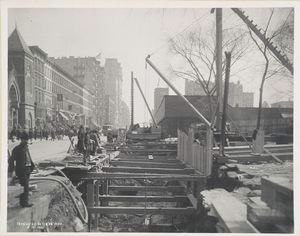Bibliography
Schivelbusch, W. (1978) Railroad Space and Railroad Time. New German Critique, No.14. Available from: [Accessed 4 December, 2012]
Oh Man It’s Total Gridlock! – Traffic and Transport in the Modern City by Amy Gear
With increasing modernisation, floods of people flock the streets of the new and improved cityscape. Life in the city was fast-paced, people wanted to get places quicker and more efficiently. This increased motion and speed allowed for the development of new technologies in transportation, hence the development of the railway. The average rail had up to three times the speed of the previously used stagecoaches. Distances almost halved allowing access within, to and beyond the city not just for the upper classes but for everyone; breaking down class distinctions and barriers. The effects of railroad travel and later the success of the automobile almost eliminates space and time. Spaces are shrinking as easier access is available and time no longer becomes an issue. (Schivelbusch, 1978. P31-40). As well as diminishing spaces, transport expands space incorporating entire nations. Entry to the city is provided for those on the edges and also provides a method of escape for those within. With the ever increasing role of transport in cities, traffic becomes a real problem. Different cities went by different local times which complicated railway schedules, as the rail network and automobile usage grew denser more and more cities are consumed by traffic. Streets become thronged by the smells of smoke and petrol, cars occupy streets and the city is transformed into a dangerous place for pedestrians and those in vehicles. One begins to question why we desire such speedy forms of transport and rapid movement. Our active lifestyle results in unnecessary accidents; loss of life and limb just to arrive to your destination as quickly as possible, is it worth it?


![Source: [Missouri Valley Special Collections , ID10009637 ]](https://bloggroupzero.wordpress.com/wp-content/uploads/2012/12/transport-9.jpg?w=584&h=667)
![Source:[USC Digital Library , accession number 3754]](https://bloggroupzero.wordpress.com/wp-content/uploads/2012/12/transport-6.jpg?w=584)
![Source: [Temple University Digital Collections, ID CPA3119]](https://bloggroupzero.wordpress.com/wp-content/uploads/2012/12/transport-7.jpg?w=584)
![Source: [USC Digital Library, ID M13820]](https://bloggroupzero.wordpress.com/wp-content/uploads/2012/12/transport-5.jpg?w=584)